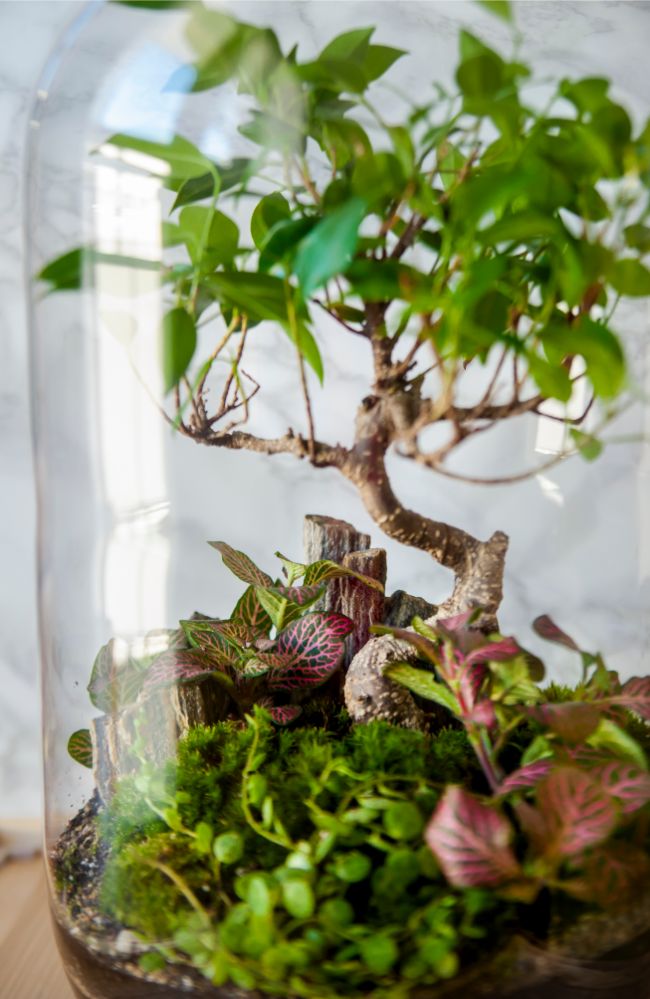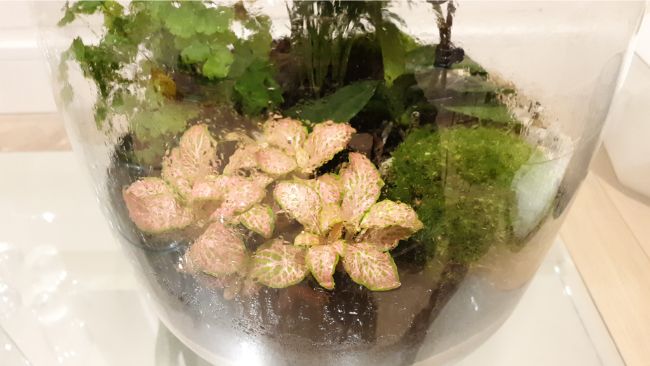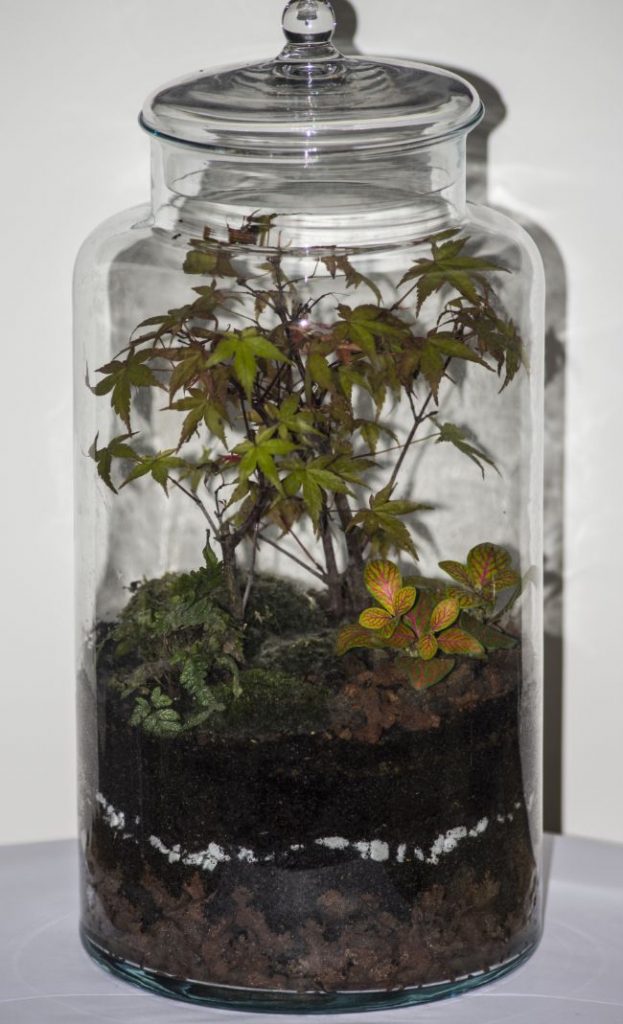How To Care For My Box Garden
Terrariums are a fun and artistic way to create a miniature botanical world. A thriving closed terrarium forms a unique ecosystem that needs little maintenance – but it does require some. Let's look at what goes into routine closed terrarium care and how to keep your glass garden thriving.
How To Care For A Closed Terrarium: An established, healthy closed terrarium can last almost indefinitely with proper attention. The primary chore is monitoring the system's moisture and making needed adjustments. Other regular tasks include pruning, transplanting, cleaning the glass, infrequent fertilization, and removing mold and dead material.
What Is A Terrarium?
There are two types of terrariums. A closed system creates a stable humid environment for plants, while open containers are subject to the outside air and dry out more quickly. Our focus is on closed systems.
It can take time to bring a closed terrarium into balance, but once the system is established it needs little water and is easy to care for. It's not unusual for a healthy terrarium to go without watering for months at a time.
How Do Closed Terrariums Work?
One of the fascinations of a terrarium is seeing how nature creates and sustains a living microcosm. Understanding how a closed system works helps you maintain it properly.
The soil within the terrarium supports healthy microbial processes that nourish living plants. Moisture from evaporation and plant transpiration recirculate as condensed "rain" droplets that keep the soil moist.
Photosynthesis powers a dynamic cycle that keeps the air healthy. The terrarium's plants use light to produce oxygen which is consumed at night; carbon dioxide is consumed during the day through photosynthesis and produced through the dark hours by plant respiration. It's quite amazing!
A terrarium's established ecosystem absorbs small changes to stay in an overall healthy balance. Yet, though nature takes care of most of the issues in a terrarium, its ecology isn't complete. It needs light and an occasional helping hand.

What Plants Do Well In A Closed Terrarium?
The plants you use in your terrarium make a difference in how easy it will be to maintain.
You don't need a huge variety of species for an interesting miniature landscape, and it's important to select plants that like the same general conditions. Key common factors include light requirements and preferences in moisture level and temperature. It's also best if they share dormancy patterns.
You don't want a plant that grows too large or too fast. Pruning can only go so far, and it becomes tiresome to continually replant overgrown specimens that take over the space. Even aggressive smaller plants can overpower an environment without frequent intervention.
A closed system makes it possible to keep tender tropical plants that wouldn't thrive otherwise. Mosses and ferns are especially attractive in a terrarium, and trendy plants like Peperomias, Pilea and Baby Tears can be easier to grow behind glass than on a dry windowsill. Exotic epiphytes and the low-growing nerve plant are excellent choices, too.
Small orchids, mini-African violets, and other flowering exotics love a terrarium environment and add vibrant color to the scene.
Closed Terrarium Light Requirements
Most terrariums require high light, but keep them out of direct sun: You don't want to create a sauna. Watch out for seasonal changes that can make the light too dim or too intense; move the terrarium as necessary.
Plant legginess indicates the light is too low. Give the terrarium a brighter location or add a grow light.
If the light comes from only one direction, rotate the terrarium occasionally to keep plant growth balanced. Artificial illumination is convenient, but you'll need to shift an angled source from time to time.
How To Water A Closed Terrarium
Watering a terrarium is usually easier than a keeping potted plant. The trick is knowing what to do … and when.
Use filtered water that has been dechlorinated to avoid burning the roots and upsetting the bacterial balance. Distilled water is good, too, and it also reduces mineral deposits.
Why Is My Terrarium Foggy?

A closed terrarium recirculates water in a process similar to natural rainfall. Moisture condenses into water drops that continually fall back into the soil. Once your terrarium is balanced, you should see droplets form near the top of the container: the glass will be clear otherwise.
Foggy glass indicates too much water in the system. This is common in new setups, but it can happen any time you overwater. The solution is simply to open the terrarium to let outside air flow reduce the moisture.
Once ventilation has cleared the glass, you can reclose the system—but keep watching. You want some condensation to form, but if fog reappears you'll need to reopen the terrarium to clear it again. Repeat the process until you see condensed droplets at the top but the terrarium's glass remains clear.
How Much Should I Water My Closed Terrarium?
A healthy terrarium has soil that is moist but not soggy. It is essential that roots can obtain water and nutrients but also breathe. Sodden soil will lead to deadly root rot.
Watch the leaves for signs of wilting or yellowing. If either occurs, check the soil to see whether it's dry or wet. Wilting in dry soil means the plant needs a drink, but if they are drooping in wet soil it signals problems with root rot.
The humidity of a closed terrarium makes the plants vulnerable to moisture-related issues, so be vigilant. It's best to catch problems early because they can ruin the system. If you see a problem developing:
- Ventilate the terrarium until the soil dries to its proper level.
- Discard decayed or decomposing vegetation. Double check for puffy stems that signal underlying root rot.
- Remove mold-covered stones or other fixtures and rinse off before replacing.
- Don't re-water the soil until the areas of decay are well dried.
- Also, remember to water less in the dormant season.
How you water is important, too. If you have a small, thickly planted terrarium, one method is to water the soil surface sparingly and tilt the container so that it spreads throughout the medium. Look at the soil saturation through the glass to make sure the moisture is evenly distributed.
For more sparse plantings or larger terrariums, it's best to water the plants individually with a syringe, dropper, drinking straw, or a small scoop. A spray bottle with a coarse stream can help avoid overwatering.
After watering, leave the top open until the plants are dry to avoid fungal issues. If you do overwater, tilt the terrarium so that water pools in one area and sponge it up with paper towels.
Closed Terrarium Humidity
Closed terrariums naturally create high ambient air moisture. Avoid light and heat extremes and don't overwater, and you won't have an issue with humidity.
Misting is sometimes recommended to keep the plants moist, but it's not always necessary. It can minimize the need for watering but doesn't replace it.
If you decide to mist – a light spritz does freshen some plants – don't overdo it. It can stimulate fungal issues. Ventilate the system afterwards until the leaves are dry.

Cleaning A Closed Terrarium
To keep your terrarium looking great and ensure light shines through, regularly clean the glass. The outside can be wiped with commercial window cleaner, but be sure to use non-toxic products on the interior sides. You don't want to poison your captive environment.
Mineral deposits form white residue on the glass over time, especially if you use tap water. (If you have a very hard source, distilled water will save you some work.) Clean the deposits with a 50%-50% mix of water and white vinegar; it will take some rubbing. Wet a paper towel with the mixture and wrap it around a chopstick if your hands are too big to reach a tight space.
To give your terrarium a polished finish, take out and rinse any piece of hardscaping covered with grit or slime. Gently wipe or spritz off leaves that have been soiled during your exertions. Let the surface moisture dry before resealing the terrarium.
Temperature Requirements
Terrariums don't make good greenhouses. Sunlight will definitely heat up the interior, but the space is too small. Temperatures can quickly soar and roast your plants.
Keep your terrarium in indirect light and let room temperature dictate their conditions. Make adjustments if the interior is noticeably different than the local temperature.
Closed Terrarium Ventilation
A closed terrarium recycles its air because the plants produce oxygen in light and consume it in darkness. This forms the main composition of the air your plants need, but this balance isn't exact. It's a good idea to open the terrarium for a few hours every two or three weeks to refresh the system.
This is a good time for maintenance. After you close the terrarium again, check that condensation reforms on the glass. If not, add a bit of water until it's rebalanced.
How To Prune A Closed Terrarium
Terrarium plants are easy to care for because they grow more slowly in the limited conditions, but healthy plants do grow. Pruning is one of the main chores in keeping a terrarium healthy and attractive.
Check your plantings objectively. Subtle changes can accumulate and gradually crowd out your carefully created scene. There are three complications to pay attention to:
- Plants grow at different speeds. You won't necessarily be pruning everything together.
- Plants may interfere with each other. Pay attention to how much light each plant receives. Even a slower-growing plant will put out leaves that can block others.
- Leaves that grow to touch the glass can attract condensation and are more prone to mold and fungal issues.
Sterilize your tools before cutting, and make sure the blade is sharp. Bruised foliage or stems invite decay.
When removing overgrown leaves, pinch them from a lower node in a place you want new growth to start. Beheading is a valuable technique for limiting the size of your plants, and it also encourages bushier growth beneath the cut.

Fertilizing A Closed Terrarium
Your terrarium's soil doesn't need much fertility – in fact, it can be counterproductive. You want the plants to remain small and contained: it's easier to maintain the system if the greenery grows at a moderate pace.
Because of this, it's not necessary to fertilize most terrariums in their first year. It's best not to put a lot of rich organic matter in the soil, either.
The leaves will tell you when they want a little boost: they grow pale when they need more nutrition. Fertilize using a balanced formula and apply sparingly with a diluted ¼ solution of the regular dose.
Maintenance For Beauty And Health
Some death and decay is inevitable. Remove declining leaves, stems, and flower parts. You don't want a lot of organic material to build up and encourage rot.
Take out plants that have overgrown the space. You can replace them with similarly sized plants so the landscape isn't drastically changed.
It's also very important to remove any plant that starts to look unhealthy. You don't want it to spread disease or garner mold that can grow to other plants. Dig it out carefully with a spoon or other tool so that other plants aren't disturbed.
Closed Terrarium Planting Tips
Closed terrarium care should be easy – here are some helpful tricks to keep it that way.
- Rinse your plants carefully before putting them in the terrarium. You don't want to introduce bugs, mold, or foreign chemicals.
- Make sure your soil is sterile to avoid bringing pests and mold spores into a closed system. Commercial mixes are usually fine, but sterilize it by baking if you have any doubts.
- Allow growing room. The plants will fill up your landscape soon enough. Minimize the need for pruning and grooming by giving the plants a margin for growth.
- Trim the roots to keep a plant smaller. Most plants are tolerant of having their roots trimmed: it's something that happens in nature. Don't cut the large tap roots, just the thread roots that grow from it.
- A good rule of thumb is to plan on replenishing your plants annually. You may get lucky with a slow-grower that looks good longer than that, but most thriving plants eventually outgrow a typical terrarium. Yearly replacements help you keep a well-tamed landscape.
Stay Alert For Mold
Routinely check the soil, hardscape, and plants for mold. It's white and fuzzy and can spread like wildfire.
Get rid of it immediately.
Put a tissue over the mold to keep spores from releasing as you take it out. If it's significantly covering a plant, consider taking it out, too.
Scratch the soil near where the mold was to expose it to air, and ventilate the container. Mold develops in moist conditions, so an outbreak is a sign of too much water. Watch the terrarium closely for new patches.
If you have an out-of-control situation, try leaving the cover off for several days to let it dry thoroughly, but if half or more of the terrarium is infected with mold, it's probably time to scrap it and start over.
Pest Problems
Humid conditions attract insects, but don't necessarily panic if you see some tiny critters. There are even a few beneficial animals that help maintain the terrarium ecology. Springtails are commonly used because they eat mold, for example. Pillbugs and millipedes feed on decaying matter.
Incidentally, one sign of bug life is little trails left in the condensation; however, the ones you need to worry about stay mainly on the plants.
Spiders, moths, and beetles, and other insects that don't eat plants may hitchhike their way in, but there usually isn't much food for them: they don't last long.
Plant-sucking pests are a bigger problem. Only use non-toxic insecticides. Remove any plant that shows signs of significant infestation – it's hard to do battle in a closed system.
Closed Terrarium Care Questions

Can you put succulents in a closed terrarium?
You can, of course, but the humidity factor works against it. Succulents do better in an open terrarium.
Can air plants live in a closed terrarium?
Yes, air plants love the humid conditions of a terrarium. They don't need to be planted in the soil, so you have more scope to place them on rocks and other hardscape. Just make sure they dry completely after watering. Some growers take them out of the terrarium to more thoroughly water and dry them.
Should I use charcoal in my closed terrarium?
Horticulture charcoal (not briquettes!) is recommended to help neutralize toxins and odors in a closed terrarium. A 1/4 to 1/2 inch layer between the bottom drainage material and moss or topsoil provides a mild buffer in a closed system by absorbing orders, harmful chemicals, and bacteria.
Read my guide to terrarium soil layers to learn how to create the ideal environment for your plants.
Does a glass jug make a good terrarium?
Small enclosed terrariums can be beautiful, but you'll need patience if using a container with a small opening. To construct and maintain them, you will need special tools including long-handled scissors, scoops, tweezers, and waterers (basters work well).
How long does a closed terrarium last?
Terrariums can be sustained for years. That isn't to say the same plants will continue to live in a closed system indefinitely, but a healthy terrarium can last for as long as you properly maintain it.
How To Care For My Box Garden
Source: https://smartgardenguide.com/how-to-care-for-a-closed-terrarium/
Posted by: reyesfewillic.blogspot.com

0 Response to "How To Care For My Box Garden"
Post a Comment